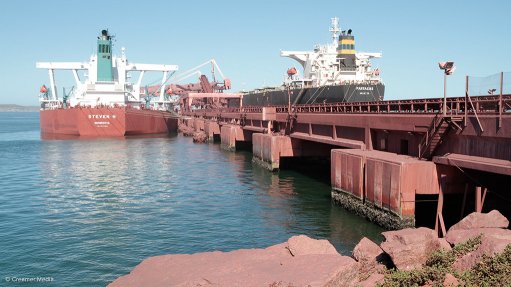
PROS AND CONS
While West Africa is competitive in terms of its low mining and processing costs and low strip ratio, the area’s competitiveness is lost at a logistics level
Photo by: Duane Daws
Despite slowing demand from China, the long-term demand outlook for iron-ore was not bleak, global commodities industry pricing and market analysis firm CRU consultant Serafino Capoferri told delegates at the fourth Africa Iron Ore conference, in Johannesburg, earlier this month.
Chinese steel consumption is expected to continue growing in the years ahead, peaking around 2020, despite the slower growth rate, he says, adding that demand for iron-ore from other emerging economies, particularly India, is expected to outstrip that of China after 2020.
Capoferri further noted that while demand for iron-ore is expected to grow, supply would likely grow even faster. This means that not all iron-ore supplies would be needed to meet demand in the long term and it is, therefore, estimated that only about 40% of the iron-ore projects currently under development will be needed to meet future demand.
Long-term iron-ore prices are, therefore, expected to fall.
In an environment of low prices, West Africa’s competitive strength, from a cost perspective, lies in its low mining and processing costs, which are a function of high in situ grades and low strip ratios.
Compared with Australia’s iron-ore mining sector, where Capoferri expects to see a fall in in situ iron grade, projects in West Africa are expected to experience an increase in in situ iron grade going forward.
West African projects also have weighted average strip ratios far below the world average, giving them more of a competitive edge, he pointes out.
Capoferri highlighted that while West Africa was competitive in terms of its low mining and processing costs and low strip ratio, the area’s competitiveness was lost at logistics level, as the largest projects and highest iron grade operations were often the furthest away from port.
“Logistics does not only affect the cost of transporting iron-ore from the mine to port; it also increases the unit costs of labour, consumables and diesel, besides others, and has a wider impact on the cost structure of a mine,” he noted.
Capoferri believes that while West Africa performs well at an in itu cost level and gains competitiveness against Australia when quality is taken into account, the area’s freight costs push it up on the business cost curve.
Meanwhile, Capoferri noted that, when evaluating the risk/reward balance for prospective West Africa projects, the more capital intensive a project, the more investment it required and the higher the risk of it destroying shareholder value.
“What we have noted in West Africa, especially in the face of the region rising as a potential iron-ore supplier in times when the iron-ore price was strong, is that the many projects approaching the market with feasibility studies [indicating] high capital costs but low operating costs are in a way trying to imitate what was successful in the Pilbara mining region in Western Australia, where economies of scale really drove the competitiveness of these operations.
“Our view, however, is that projects similar to this are not efficient from a risk/reward perspective, as all of them face the challenges of delays and struggle to obtain financing from investors.”
Capoferri suggested instead that the value of these projects be increased by reducing the capital costs they required, even if it implied higher operating costs.
Therefore, from a risk/reward perspective, the smaller operations were often of higher value in a region characterised by higher marginal costs of capital, he said.